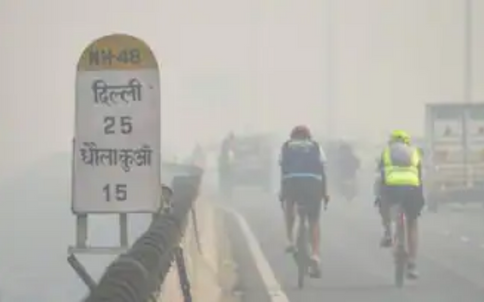Musings by Shekhar Nambiar
As I pen this piece, I’m compelled to look at two things that are as diverse as diverse can be. The first is about a song and it pleases us. The second is distressing and alarming, the looming environmental crisis.
The good part, first. It’s about an interesting song that came last December, from the south, and from the film ‘Pushpa’.
Also read: A festival goes global
The film released in December 2021 in five languages, the original in Telugu (Pushpa: The Rise).

A lilting song
It’s a peppy number with a rustic tilt that has won the hearts of the youth and caught their imagination. The interesting bit is that despite it being several months since its release, ParvaiKarpooraDeepam continues to make waves.
Also read: Boom town, difficult roads
The last time a pop song made a big mass appeal and impact was over10 years ago when Why this Kolavari Di became the craze. Nobody knows why. For, its lyrical quality was no great shakes. Based on an old south Indian folk tune it had composer Anirudh, Shruti Haasan, Aishwarya and Dhanush, who also sang and penned the lyrics. The song spread like a wild fire through the Internet.
ParvaiKarpooraDeepam is much more melodious and action packed with Allu Arjun and RasmikaMandanna on screen. ‘Pushpa’ is estimated to have grossed INR 355-365 crores at the box office.
Reviews of the film have been so-so, a mixed bag; very much a rustic, masala potboiler – largely centred on a coolie turned sandalwood smuggler. But that’s not the point. People have been taken in, rather enamoured of, by this song rendered beautifully and picturized as a song and dance sequence.
So enchanted are they with the song that its adapted video versions have had people glued to the YouTube.
Also read: Autumn of 1971
The southern film industry has long been bringing beautiful songs, and lately peppy and folk-based melodies too. Adaptations if any, notably from Hindi films, have been few and far between. If anything, the flow has been in the opposite direction, with mostly adaptations by Bollywood.

November woes
Now to the disturbing and depressing part. A development of note in November is the rise in smoke levels to dangerous levels in North India.
Also read: Living next door to Gurugram
Whatever reasons are attributed to this, the high pollution levels are taking a heavy toll on people not only with existing health conditions such as allergy and other ailments, but also normal healthy people as well. Experts have warned of serious long-term repercussions on people’s health, including reduced life expectancy and so on.
November brings in its wake smoke clouds visible not only from satellite images high up in the atmosphere but it is also apparent to inhabitants on ground and affecting everyone hard and severely.
This is the time when farmers in north-western parts of India burn excess paddy straw following the harvest of rice.

Plume of smoke
A November 1 afternoon satellite image showed a plume of smoke from north-eastern parts of Pakistan enveloping Punjab, Haryana and UP, with it pinpointing the locations where stubble was being burnt.
Also read: Megacity Mumbai as I recall
The air quality index went upto dangerous levels – to 424 on that day, with the Central Pollution Control Board pegging it into the ‘severe’ category. And it continues to be at dangerously high levels.
As is often the case during these difficult months, the pollution level has forced the authorities to stop construction activity that can contribute to significant increase in pollution levels. Stricter measures have been taken or are in the offing.
Severe curbs
Measures likely to be imposed soon include possibly a ban on plying diesel vehicles or even the much-touted private vehicle odd-even reg numbers on roads.

Crop fires are not the only contributor to the hazy skies. Dust from the Thar Desert to the west also cause particulate matter to be suspended in the atmosphere, as witnessed on October 31 this year.
Also read: Why oh why do I love Kochi!
There’s also a range of other human-induced factors that add to air pollution causes, not least from motor vehicles, industrial and construction activity, fireworks, and fires for heating and cooking. But there’s no denying that the PM 2.5 small particulate matter does cause considerable harm and angst. A study has it that as much as 14% of Delhi’s PM 2.5 is attributable to stubble burning.

Stage IV GRAP
Not surprising, therefore, that Delhi is going in for Stage IV of the Graded Response Action Plan (GRAP) to avoid further deterioration of overall air quality. What this will entail is a slew of steps to stop matters from worsening with Delhi already reeling under an Air Quality Index (AQI) graded as ‘severe’. These measures will also include, among others, closure of schools, all industrial activity and ban on entry into the Capital of trucks. The situation is also likely to be exacerbated with the calm air and stable atmospheric conditions hindering pollutants to drift away.
The prognosis is not good at all. A study by Hiren Jethva, a senior research scientist with the University of Maryland, Baltimore County and Morgan State University, predicts that NASA’s satellite ‘Acqua’ will detect at least 15,000 fires burning on the ground by late November, making it the fifth most “active season” since 2002.
What this would mean for the people living in the northern regions of India is not difficult to guess or comprehend. Unfortunately, the major proportion of victims of the calamity is likely to be children who are most susceptible to being exposed adversely.
Isn’t it time that we gave some thought to our children’s future!
Also read: Road to a carbon-free future




